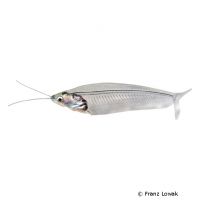Siamese Glass Catfish (Kryptopterus minor)
| Siamese Glass Catfish Kryptopterus minor | |
|---|---|
| Name | Siamese Glass Catfish |
| Name Lat. | Kryptopterus minor |
| Family | Sheatfishes |
| Family lat. | Siluridae |
| Order | Catfishes |
| Order lat. | Siluriformes |
| Origin | Southeast Asia |
| Habitat | Streams, rivers, floodplains |
| Diet | Carnivore |
| pH | 6.5-7.5 |
| Behavior | Peaceful |
| Keeping | Group |
| Care Level | Moderate |
| Reproduction | Substrate spawner |
| Breeding | None reported |
| Life Span | 6-8 years |
| Protection | No |
| Metric Units | |
| Size | 8 cm |
| Temperature | 21-26 °C |
| Hardness | 5-15 °dH |
| Aquarium | 80 cm / 110 l |
| US Units | |
| Size | 3.1" |
| Temperature | 70-79 °F |
| Hardness | 89-267 ppm |
| Aquarium | 30 gal |
Distribution and habitat
The range of the Indian Glass Catfish extends from Thailand and Malaysia to Borneo. They live mostly near the banks of slow-flowing or stagnant waters, such as rivers, streams and floodplains with dense aquatic vegetation.
Maintenance
They need an aquarium with dense planting reaching the surface, with roots and floating plants that serve as shelter and retreat, as well as free swimming space in the current. A dark bottom covered with some foliage (sea almond leaves) and shaded light (floating plants) is ideal.
No ammonia, ammonium and nitrite should be detectable, the nitrate value should not exceed 100 mg/l. To ensure water quality and oxygen content, a filter and heater adapted to the aquarium size is required, as well as lighting for the species-appropriate day-night rhythm of the animals.
Diet
Since they do not eat from the surface or the bottom, they need food that remains in suspension for a long time. The food supply consists of live and frozen food. Feed once daily with cyclops, daphnia, bosmids, artemia or white mosquito larvae (live or frozen). Protein-rich suspended dry food (flakes, granules) is also often accepted.
They are slow eaters. It is recommended to feed small portions several times a day. Only feed as much as will be eaten within a few minutes. A regular and varied diet promotes health and increases resistance.
Behaviour and compatibility
They are calm fish that like to be in a shoal among plants and are well suited for a community tank with calm, peaceful and not too large fish. At least 5, but preferably much more Indian Glass Catfish should be kept together. In small groups they remain shy and skittish.
Basically, only compatible fish species with similar demands on water condition and water temperature should be socialized.
Sex dimorphism
No external sexual characteristics are known.
Reproduction and breeding
There are no known reports of successful breeding in the aquarium.
Important
When socializing with other fish, ensure that these slow eaters receive adequate food, so small portions should be offered more often
Their anatomical feature, the nearly transparent body, is an ecological adaptation designed to provide protection from predators in the wild. For predators, their glassy bodies are difficult to detect (somatolytic function).
They are often confused with Kryptopterus bicirrhis (Asian Glass Catfish), which grows up to 15 cm and is extremely rare in the trade.
The well-being of the fish should be checked regularly. Temperature should be checked daily, pH, hardness and nitrate levels should be checked at least every 14 days. Regular partial water changes are recommended, even if the contaminant level has not yet reached the upper limit. Sudden changes in water quality should be avoided. Newly introduced fish must be accustomed slowly to the water in the aquarium.
Further literature can be found in your pet store.
References
Text: petdata; Image: Franz Lowak
Source: BMELV (1998): Tierschutzgutachten - Haltung von Zierfischen (Süßwasser); RIEHL & BAENSCH (2006): Aquarien Atlas Bd. 1, Mergus Verlag; ENGELMANN (2005): Zootierhaltung - Tiere in menschlicher Obhut: Fische, Verlag Harri Deutsch
- Gemäß § 21 Abs. 5 Tierschutzgesetz idgF
